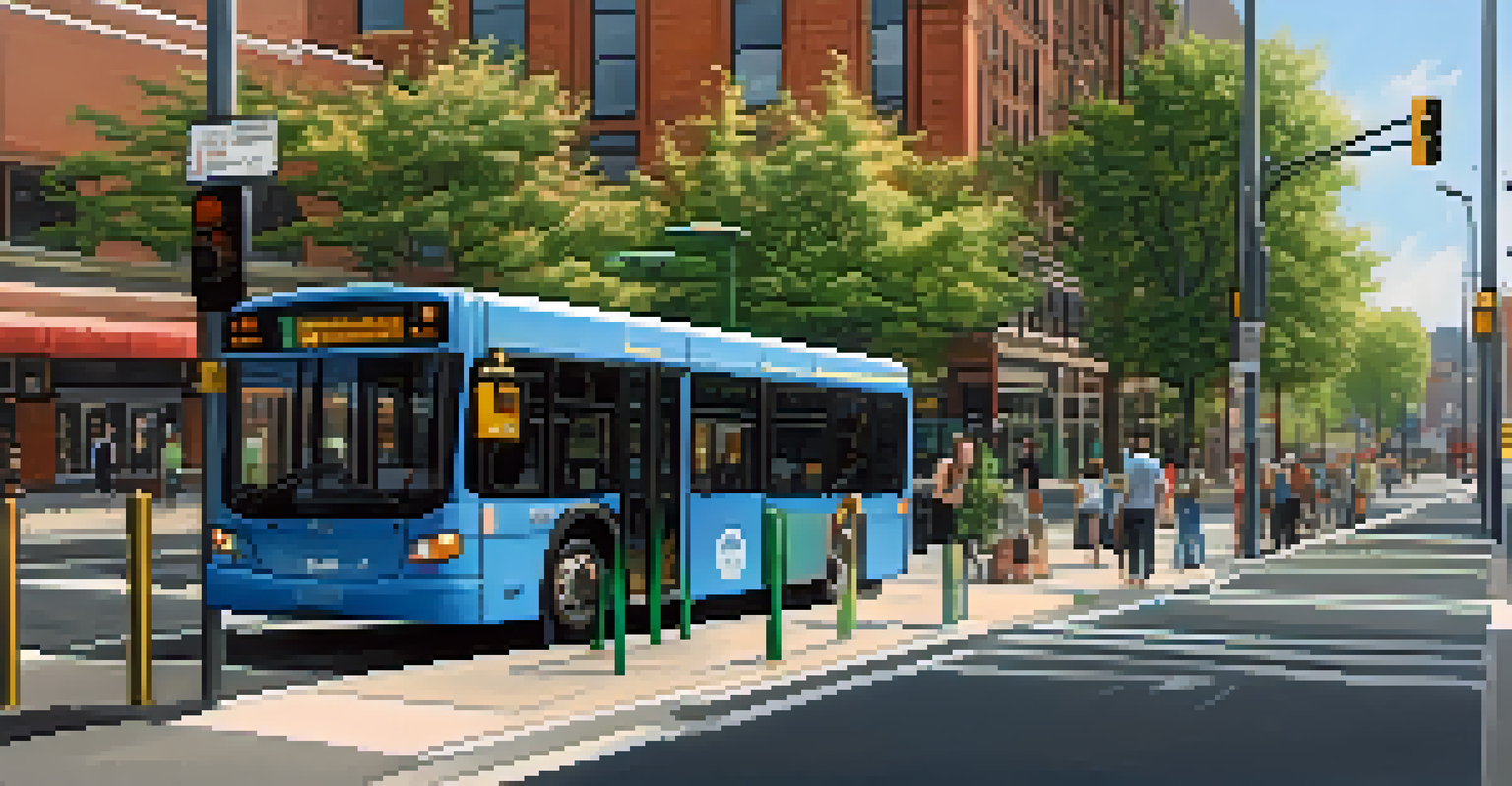Comparative Analysis: Newark vs. Other NJ Transportation Hubs

Understanding Newark's Transportation Landscape
Newark, located in Essex County, is a pivotal transportation hub in New Jersey. With its strategic location, it serves as a gateway not only to New York City but also to various parts of New Jersey. The city's infrastructure includes Newark Liberty International Airport and a robust train and bus system, making it essential for commuters and travelers alike.
Transportation is the backbone of any city, enabling people to connect, commute, and thrive.
In terms of public transport, Newark boasts the Newark Light Rail and several NJ Transit lines that connect it to major cities. This accessibility is a significant factor for residents and businesses, as it facilitates easy movement within and beyond the city. Moreover, its proximity to major highways further enhances its appeal as a transportation hub.
When comparing Newark to other hubs in New Jersey, such as Hoboken and Jersey City, it's essential to consider factors like passenger volume, connectivity, and amenities. Newark generally sees a higher volume of traffic due to its larger airport and central location, setting it apart in the state's transportation landscape.
Comparing Newark Liberty International Airport
Newark Liberty International Airport is one of the busiest airports in the United States, and it significantly impacts Newark's status as a transportation hub. It serves as a primary gateway for international flights, providing vital connections to global destinations. This makes Newark an attractive option for travelers seeking convenience and accessibility.

In contrast, other New Jersey airports like Trenton-Mercer and Atlantic City International serve fewer passengers and offer limited flight options. While they cater to specific regional needs, they cannot compete with Newark's extensive flight network and international reach. This difference positions Newark as a leader in air travel within the state.
Newark: A Transportation Hub
Newark's strategic location and infrastructure, including its airport and rail connections, make it a key transportation hub in New Jersey.
Additionally, Newark Liberty's ongoing renovations and expansions promise to enhance traveler experience, further solidifying its role in the New Jersey transportation ecosystem. Such improvements highlight the city's commitment to maintaining its competitive edge in air travel.
Examining Newark's Rail Connections
Newark's rail connections are a cornerstone of its transportation system, connecting it with various destinations across New Jersey and beyond. The Penn Station in Newark serves as a major hub for NJ Transit and Amtrak services, providing quick access to New York City and other key locations. This connectivity is vital for daily commuters and long-distance travelers alike.
The best way to predict the future is to create it.
When compared to rail services in other New Jersey cities like Hoboken, Newark offers a broader range of service options and frequency. While Hoboken serves as a significant terminal, it primarily connects to the PATH system and offers fewer NJ Transit services than Newark. This makes Newark a more versatile choice for those relying on rail transport.
Moreover, the recent upgrades to the rail infrastructure in Newark have improved efficiency and reduced travel times, making it a more appealing option for commuters. This continued investment in rail services underlines Newark's commitment to enhancing its transportation capabilities.
The Role of Newark's Bus Services
Bus services play an integral role in Newark's transportation framework, with multiple NJ Transit bus routes operating throughout the city. These services connect residents to nearby cities, shopping centers, and employment hubs, making public transport an accessible option for many. The extensive network of bus routes complements the rail services, creating a comprehensive transportation system.
In comparison, bus services in cities like Jersey City are also robust, but they often focus on specific routes leading to New York City. Newark's bus services, on the other hand, provide a wider range of local and regional connections, demonstrating a more inclusive approach to public transportation. This flexibility is advantageous for those who rely on buses for their daily commutes.
Affordable Public Transport Options
The city offers competitively priced public transportation, enhancing accessibility for residents from diverse economic backgrounds.
Furthermore, Newark's investment in improving bus facilities and services enhances the overall travel experience. Modern amenities, such as real-time tracking and comfortable waiting areas, contribute to making bus travel a viable option for many residents.
Impact of Major Highways on Newark's Transportation
Newark's strategic location along major highways like I-95 and I-78 significantly influences its transportation dynamics. These highways facilitate easy access to neighboring states and cities, making Newark a convenient stop for travelers. The connectivity provided by these highways is a crucial element for both local residents and businesses.
In contrast, while cities like Camden and Elizabeth also have highway access, Newark's position as a central hub allows for more extensive traffic flow. The combination of airport, rail, and bus services with major highways creates a seamless transportation experience for those traveling in and out of the city.
Moreover, the ongoing infrastructure improvements to Newark's highways aim to reduce congestion and enhance travel times. Such developments not only benefit commuters but also support local businesses that rely on efficient transportation for their operations.
Analyzing Affordability and Accessibility
Affordability and accessibility are paramount when considering Newark as a transportation hub. Public transportation options like buses and trains are generally priced competitively, enabling residents from diverse economic backgrounds to access essential services. This affordability makes Newark an attractive option for those who prioritize budget-friendly commuting.
Comparatively, transportation costs in cities like Hoboken can be higher due to the overall cost of living. While Hoboken offers a vibrant lifestyle, its transportation expenses may deter some commuters. Newark's balance of affordability and accessibility caters to a broader demographic, enhancing its appeal as a transportation hub.
Future Developments Enhance Connectivity
Ongoing projects, like the Gateway Program and light rail expansion, promise to improve Newark's transportation efficiency and reach.
Additionally, ongoing initiatives to improve accessibility for individuals with disabilities demonstrate Newark's commitment to inclusivity. These efforts ensure that all residents have access to transportation options, further solidifying Newark's role as a welcoming hub for everyone.
Future Developments in Newark's Transportation System
The future of Newark's transportation system looks promising, with several planned developments aiming to enhance connectivity and efficiency. Projects such as the Gateway Program, which seeks to improve rail infrastructure between Newark and New York, are expected to significantly reduce travel times. Such advancements will not only benefit commuters but also encourage economic growth in the region.
In addition to rail improvements, Newark is also focusing on expanding its light rail system to better serve underserved neighborhoods. This expansion will enable more residents to access public transport, reinforcing Newark's commitment to equitable transportation options. As the city evolves, these developments will play a critical role in shaping its transportation landscape.

Moreover, Newark's collaboration with state and federal agencies on various transportation initiatives highlights its proactive approach to future challenges. By investing in sustainable and efficient transportation solutions, Newark is positioning itself as a leader in New Jersey's transportation network.